Abstract
Adoption has been a very common legal construction since time immemorial in multiple Western European and other cultures, although it has not been treated equally everywhere. A formally adopted child is legally permanently imputed to the kinship of the adoptive parents who took pity on the vulnerable child and consequently completed the legal process of adoption to take the person into a relationship he or she did not previously occupy. In principle, the motivation behind an adoption should play no decisive role in considering the applicability of the relevant legal norms. The typical motivations range from a burning longing in the potential adoptive parents to fulfil their parenting wishes and a healthy developed sense of empathy with a chosen orphan who can thus be spared growing up in an orphanage. In some comparable Continental legal systems not only children below the age of majority but also adults may be adopted. In those circumstances the motivation is less the result of empathy with the vulnerable potential adoptee. More often it is to accommodate the special needs or interests of the adopting “parent”; also the reason that governed the origin of de jure adoptions in Roman law. Some examples of the motivation behind contemporary adult adoptions in comparable Continental legal systems is discussed with reference also to the unexpected consequences of such adoptions. Regardless of which personal consideration motivates a potential adopter to consider adoption, it should be based on a conscious decision by the adoptive parent to accept the chosen person as an adopted child within the family. Although it should be concluded that adoption rests on a considered voluntary decision on the part of the prospective adoptant to add the chosen person to his family, well-defined legal norms ensure that adoption is no longer treated merely as a contract between interested parties such as for the acquisition of a puppy as a new pet. In the interests of legal certainty, the law does not attach all the consequences that parties intended with their volition, to such volitional decisions. After a finalised legal adoption it would be to the detriment of legal certainty if a mere change of mind on the part of a whimsical adopting parent would suffice to undo retroactively the consequences of the change in the status of the adoptee. Presumably few scholars may consider that current South African law provides for adult adoption. Although the applicable South African statute does not explicitly govern adult adoption, it is submitted that this should at least be considered if a nearly adult person who is already legally married is chosen for adoption before he or she has reached eighteen years of age. The Children’s Act stipulates that it is only when a person reaches that age that he or she is no longer a “child”, and all children, in principle, are adoptable. Although the current Children’s Act refers extensively to the requirement of “consent” with regard to adoption, no mention is made of the obvious prerequisite that the potential adopter must voluntarily decide to adopt the chosen person as adoptee at the final conclusion of the adopting process. The law does not require that there must be an agreement between the biological parent/s and the adoptant nor between the latter and the adoptee as is required for a contract, but no one should be forced to adopt a child against his/her will, nor vice versa – irrespective of whether it may be considered to be in the best interest of the child. Legal certainty will be compromised if decisions on the adoption of a supposedly chosen person are made randomly by judges without regard to the crystallised applicable legal norms merely by justifying the decision with reference to ubuntu. This may well deter prospective adopters from considering adoption as a viable construction. The need for legal certainty regarding the protection of the interests of vulnerable children was the primary consideration for the then South African legislature to pass the first Adoption of Children Act 25 of 1923. The legislature noted the growing problems and legal uncertainty with unregulated de facto adoptions. Notwithstanding the foregoing historical fact, Lekhuleni J in the recent RS case argues that in the interest of de facto adopted children, the well-defined legal norms that had been accepted as crystalised may be abandoned: “Undoubtedly, the recognition of de facto adoptions for the purposes of care, maintenance and proper parental care ensures that the protection of children for whom the adoption statute was intended is not eroded” (par 31). This reasoning apparently sufficed for the court to decide that the defendant may simply be confronted with a child as an adopted child notwithstanding the fact that the ordered finalisation of the adoption process cannot be termed to be the result to which he still voluntary consents. Since his marriage had already ended in divorce more than five years previously he may not have had the intention to continue with any potential adoption procedure regarding a foster child the erstwhile couple took in as foster parents more than ten years previously. It is submitted that nobody should be compelled to accept even a stray dog as a pet against his will and even less so a child as an adoptee – sed, ex Africa semper aliquid novi.
